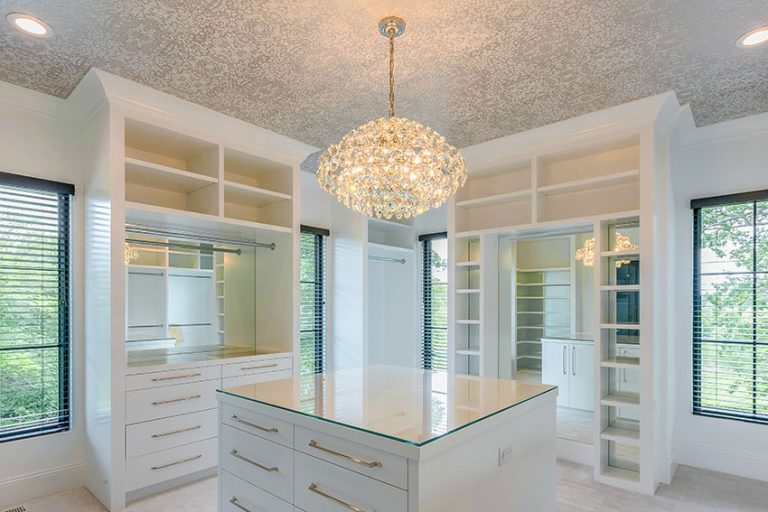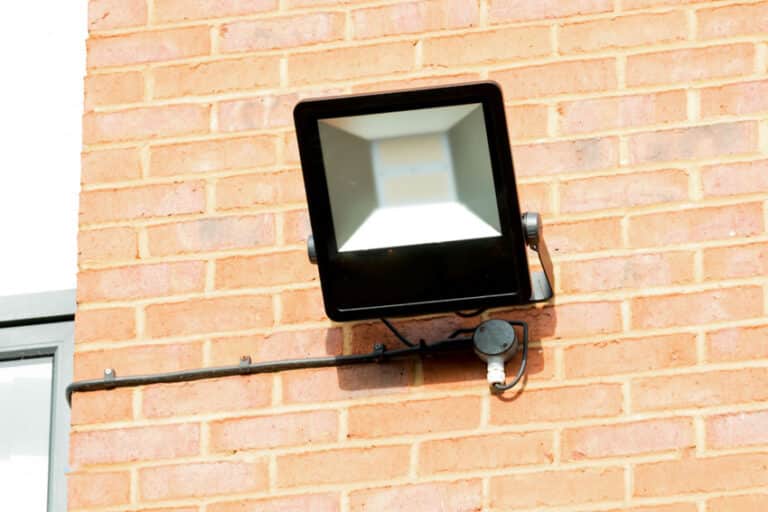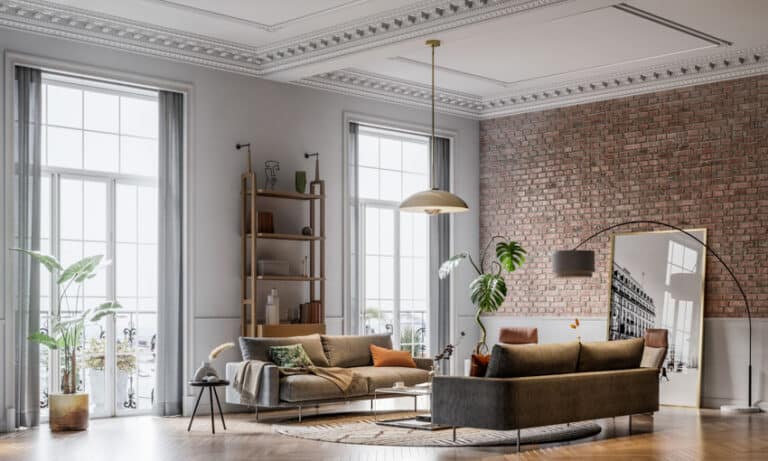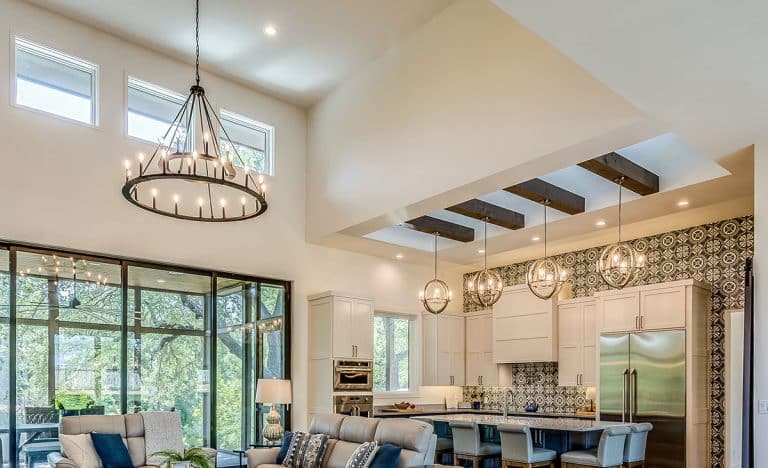15 Fence Lighting Ideas With Post & Rail Designs
Most fences are focused on security and protection, and aesthetics come last. But it doesn’t mean that you can’t ensure it looks stunning enough to make an incredible first impression. One of the ways to do this is by choosing the right fencing lighting.
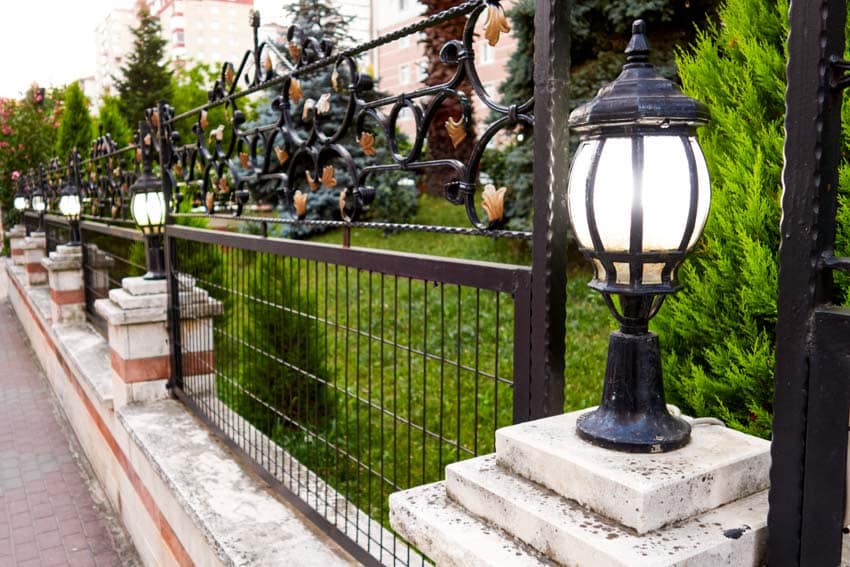
Lighting is a functional, practical, and aesthetic element essential to your home. It’s important to consider your options thoroughly for your fence lights.
Here are some reasons why excellent fence lighting can do wonders for your home.
- Helps create a more comfortable and inviting space
- Defines the space of your yard
- Adds an element of security and safety to your property
- Elevates your garden to a lively space for entertainment or relaxation
If you’re set on having fence lighting for your home, there are several types you can consider. Whether you’re prioritizing your budget, security, or aesthetics, there will always be something you can choose.
Types of Fence Lights
To give you a head start, here are some types of fencing lights you can explore and consider.
Post Lights
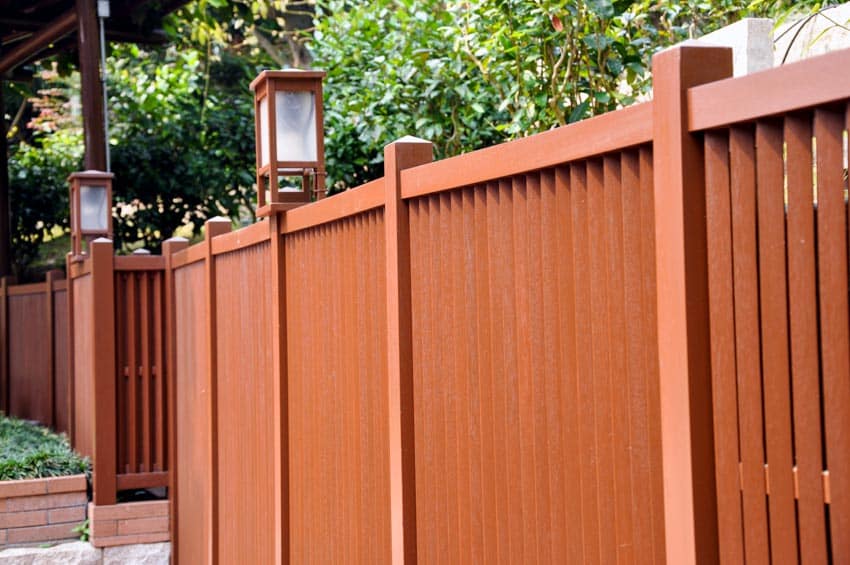
Fence post lights can be considered for your home, and they’re, in fact, one of the common options for many homeowners. These lights can either be solar-powered or hardwired, and they are an excellent option for both security and landscape lighting.
You may need to place lights on the top of your fencing (preferably posts). The effect of this placement will result in the illumination being projected outward and upward.
The standard for posts measures around 4-inch by 4-inch and the installation is straightforward and easy. You can also choose between a simple or a decorative post light, depending on your preference.
While post lights are common for wooden fences, you can install them over vinyl, metal, and concrete structures. If you have more stable and durable fencing, you can install a larger, heavier lighting fixture if preferred.
Rail Lights
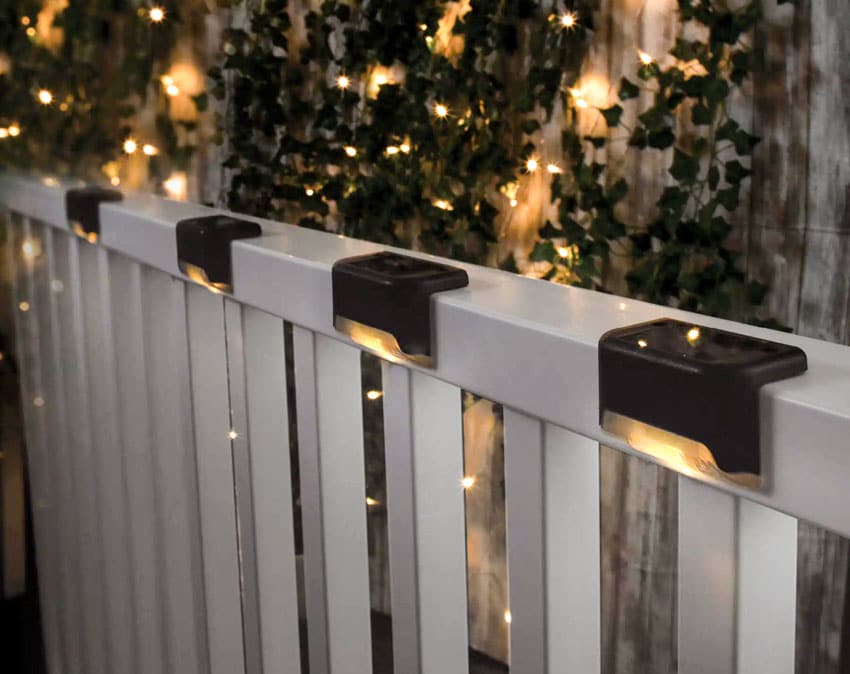
If you have rails for a fence, post lights won’t really work best for you. The best option to consider is rail lighting. There are posts even with railing, but most have a bit of distance between them, which means that putting them on top of the posts is not as effective as placing them on the rails.
The middle area between the posts will be darker compared to the areas where the posts are. With fence rail lights, a cap may be needed on every post to secure them into position.
Fence rail lighting fixtures offer better coverage than post-lights since more areas are lit. Meanwhile, post lighting is only limited to posts. And with railing fence designs, they are even more limited.
Solar Lights
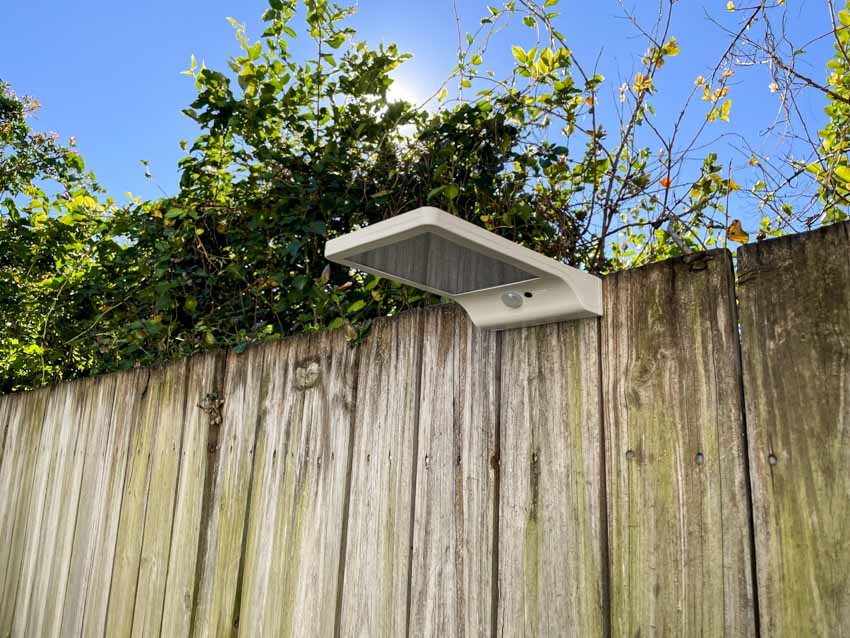
Solar fence lights are also a wonderful choice. Compared to regular post or rail options, solar fencing lighting is guaranteed to be more cost-effective. This is in addition to actually making your home look livelier and more festive in the evenings.
Considered to be a smart choice, solar fence lights are safe and easy to install (you can just do this with hooks). You won’t have issues raising or wiring them since they are solar-powered. They are designed to automatically turn on at night, while in the morning, they are fully charged up by sunlight.
Since solar fence lights are small and low-profile, you can easily install them on top if you have a railing or flat fencing. You just have to make sure to position them effectively so they can maximize solar consumption.
Solar Post Light
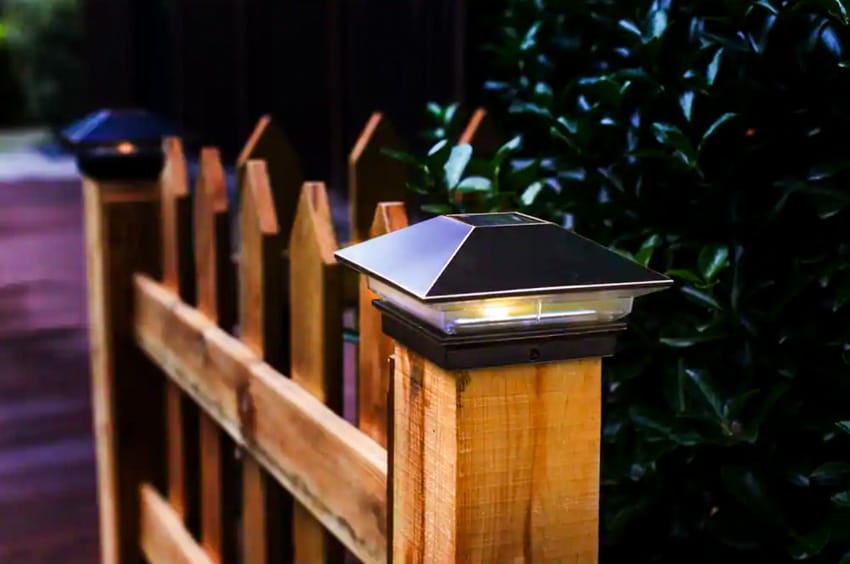
If you’re into post-lighting but want a smarter and more cost-effective fixture for your fence, a solar-powered option may be ideal. Just like how it’s named, the solar light will be limited in the posts of your fencing.
Compared to the standard outlet-powered fixtures, you won’t have to worry about the wiring of the solar-powered post lights. Instead of installing solar lights in the rails, use taller posts with better sunlight access.
More than just its easy and convenient installation, you can also be sure that you’re minimizing your carbon footprint and, in some way, contributing to preserving the environment.
LED Lighting
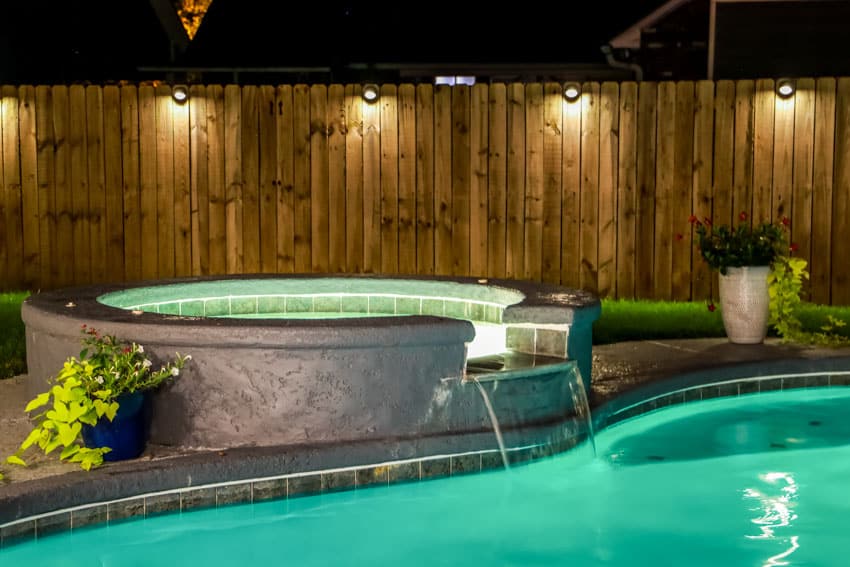
LED (light-emitting diodes) involve tiny electronic components that are more durable and break less. Compared to standard types, LED lighting remains cool even when in operation, leading to a longer lifespan.
LED fixtures also feature brighter illumination, but you will still need to install a couple of LED lights to be able to illuminate the entire garden area.
There are two ways you can go with your LED fence lighting. You can either use the hardwired approach or the more cost-effective option, which involves the solar alternative.
The former uses a wiring system connecting the light fixture to a single circuit, while the latter has the sun as its power source, making this option more cost-effective.
Low Voltage Lighting
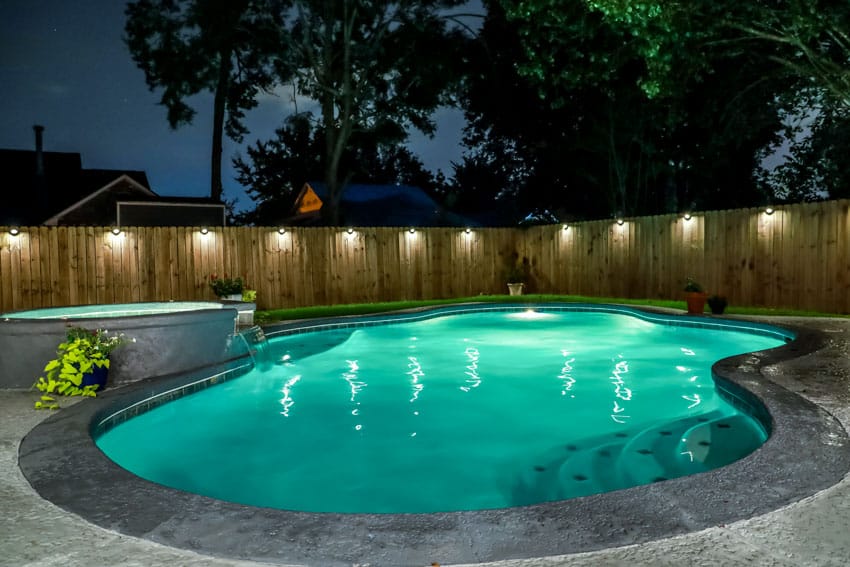
When it comes to outdoor lighting, low voltage is an excellent choice. It offers more energy than the standard voltage lighting because of a step down in power consumption.
The standard voltage uses 120V, while low-voltage lighting uses around 12V to 24V. Besides having cheaper light fixtures and bulbs, low power also removes the danger of shock.
Like all other types of fencing, the number of fixtures you can install and use will be limited by the wattage of the transformer you’re using. And the downside is that the bulbs would need to be replaced often since they don’t last that long.
Hanging Lights
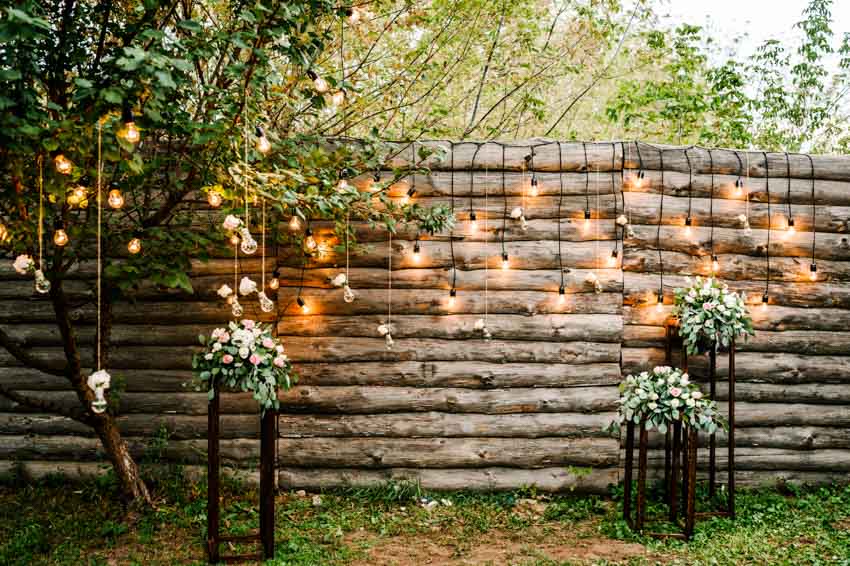
Hanging lights can also be used on your fence and are commonly used for aesthetics and decor. Also known as curtain lighting, this versatile style is a decorative choice for your fencing.
Hanging lights can easily be strung across your fence, and it doesn’t matter what type you have as long as you position them effectively and decoratively. This produces an ethereal glow that will look fantastic in your garden.
You can set the hanging lights like a curtain and drape them on the fencing. Most of these lights have already been made to resemble curtains, so you won’t have to add any effort to make designs using them.
Using multiple strands to create a curtain of light, you can run them vertically and closer to each other to have denser-looking hanging lights. You can even go for standard white or multi-colored string lights.
String Lights Around Fence
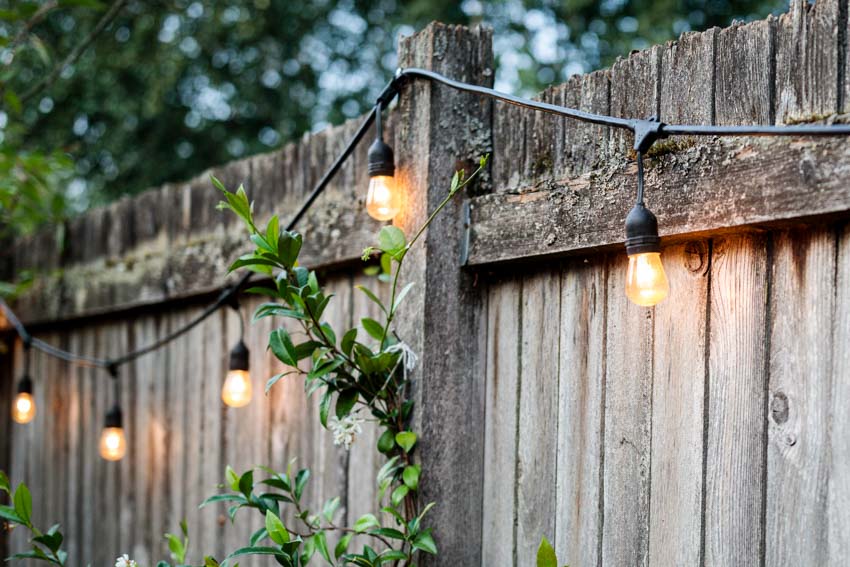
One of the best lighting ideas for your fence is string lights, considering they can also be used as decor in the backyard to create a specific ambiance. Also known as fairy lights, these string lights are powered by either the sun or a battery.
This saves you the trouble of turning the switch on and off with every use. In addition to that, you won’t even have to ask for a professional’s help when setting them up.
While hanging fixtures are denser, string lights are named as such because they come in a string. This means you have more creative freedom in styling their mounting on your fence. You can also go for clean, bright white, or warm color temperature bulbs for a more relaxing and inviting vibe.
Downlighting
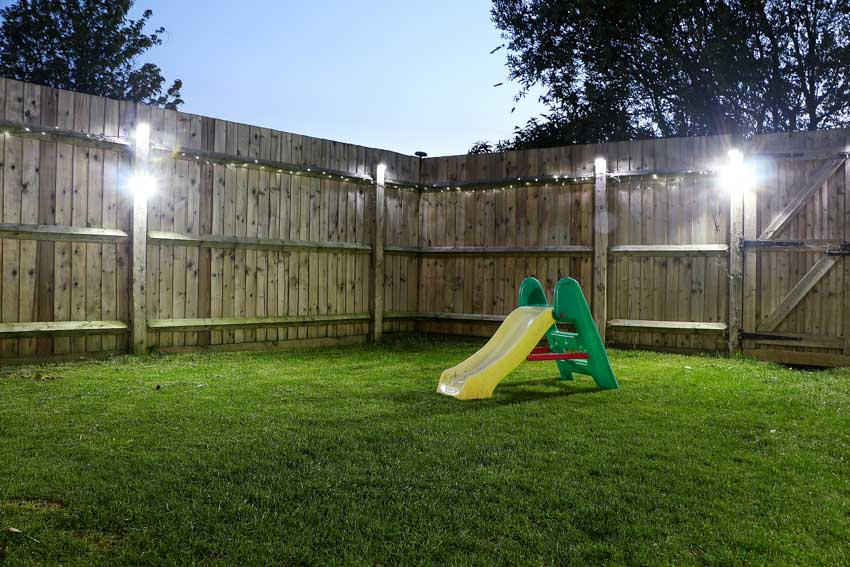
Usually flush-mounted on the ceiling, fence downlighting can also be used outdoors at the base of your fencing (and even underneath your patios) as uplights.
This lighting style can create a hidden and well-lit entryway for your home. More than just adding to the comfort and security at night, positioning the flood light fixtures at the base of the fence produces a dramatic look that can elevate the landscape of your home’s front yard and back.
Fence downlighting is usually composed of pinpoint and small LEDs installed in specific positions to improve the ambiance and look of the fencing and backyard. You can easily spruce up everything, from plants to landscaping.
Hardwired or solar-powered downlighting is not just a stunning addition to your home but can also help to define the borders and boundaries around the property.
Multi Color Lighting

Another option you can do with your fence is to apply multicolor lighting to turn it into a lively space. If you’re thinking about Christmas lights, that’s the same effect that multicolor lighting can produce.
This lighting is fun and adds life to your fencing and your home in general, creating a first impression that is grand and festive. The people who live inside seem fun and not boring at all.
Multicolored fence lighting can come in a variety of fixtures, from bulbs inside posts to hanging styles and string lights.
Modern Lights
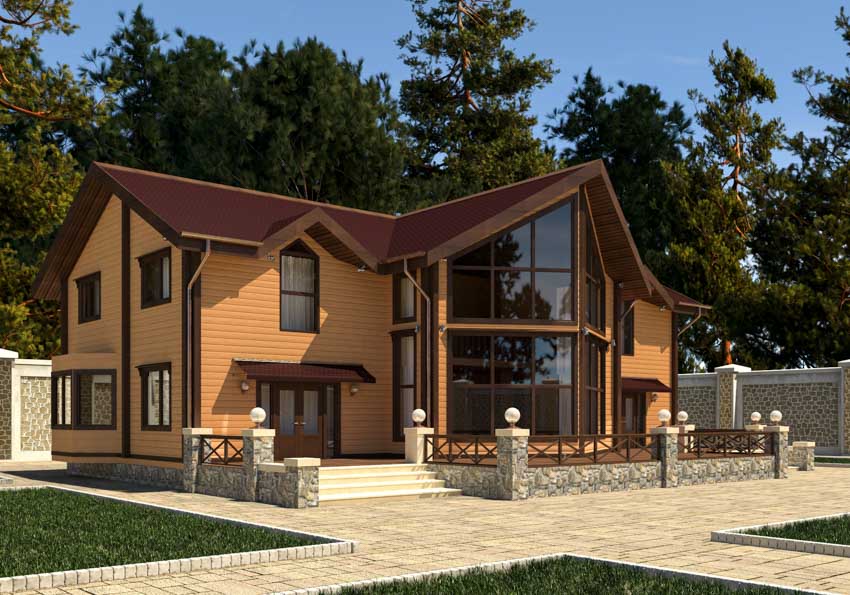
You may also want to consider modern fence lights for your home if you’re looking for something trendy and stunning. Many modern fence lights are straight-up LEDs because of the clean and edgy look that white diodes can produce.
Modern lighting can be expansive in its aesthetics, from the effects of the decoration to the fixtures used to create this effect.
You can choose to have modern wall fittings in the form of wall lamps and wall lights, and adding something geometric in design to the mix will accomplish this modern look.
Antique Style
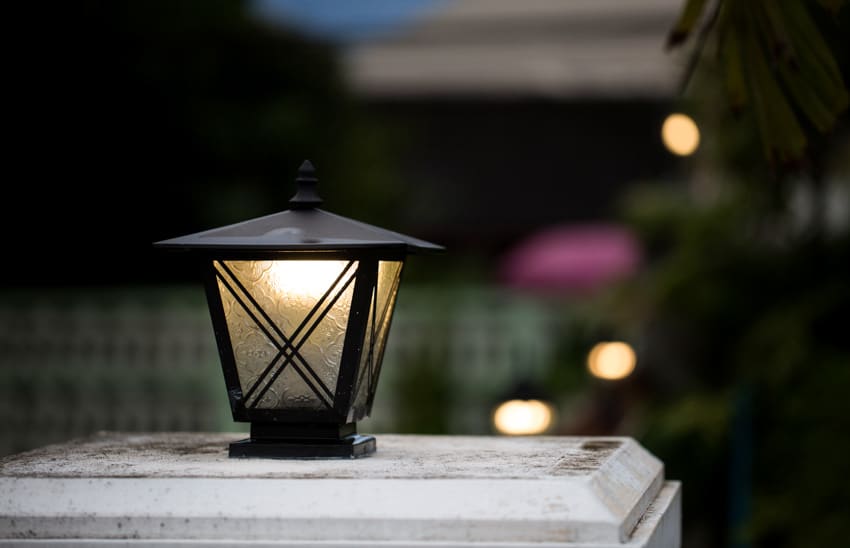
The opposite of modern lighting is antique-style, which can take you back to the past. Regarding antique style, you’re dealing with lighting fixtures with artistic and intricate details and elements.
You can install these antique-styled fixtures on your fence, particularly posts or railings. Doing so will create an elegant feel similar to the feel of castles and temples.
Just like most fencing types, the trick is to space lighting fixtures well to have more coverage and offer brighter space at night. It’s also necessary for the intricate designs to be seen even in the dark to be well-appreciated.
Lantern Style
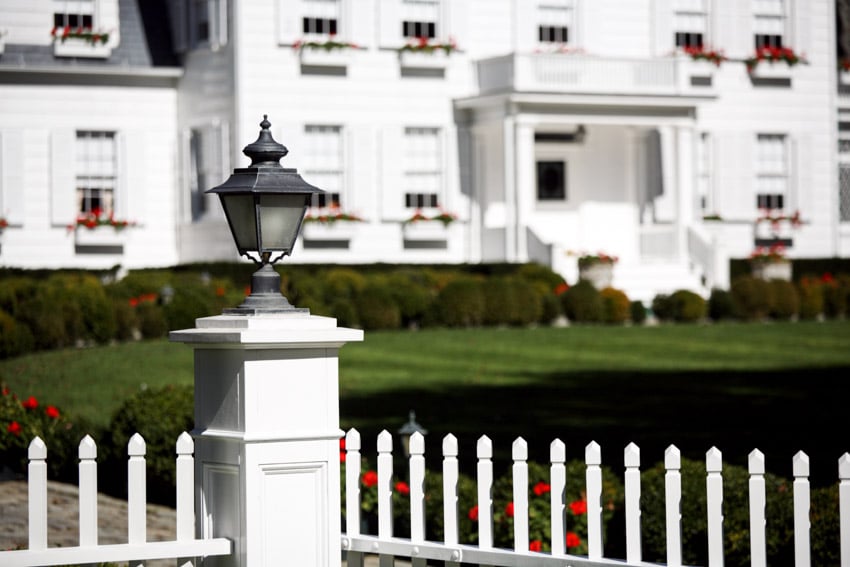
Lanterns are some of the oldest lighting fixtures in your history books. The trick in using lanterns in modern times, though, is to be artistic and tasteful. Generally, lanterns with real fire are not convenient and safe to use with your fence, especially if you have a wooden fencing.
It cannot be denied though, that lanterns always have stunning designs, even when their sizes and colors vary. And hanging lanterns on your fence would look wonderful.
Rather than using actual fire, you can be relatively modern in your approach of using lanterns. Instead of real candles, you can use battery-operated candles or even fairy lights and stuff a bunch of them into the lanterns. Mason jars have become popular as lanterns and can be paired with string lights for a stylish yet rustic feel.
Globe Lights

While lanterns are elements of the past, globe lights belong in the present modern time. These fixtures are large and round circular-shaped globes encasing the bulbs, precisely how they got their name.
They are often used as a decorative element, particularly in restaurants and bars, where aesthetics is also important.
Globe lights measure twice as big as the standard GLS bulbs, which means they can’t be used in smaller lamps but would be a bit small to be used as large ceiling lights.
If you add globe light bulbs to your fence, they’re easy to look for in the market due to their large and round shape. And the best thing about them is that they are mostly LED, and so are energy-saving.
Sconce Lights
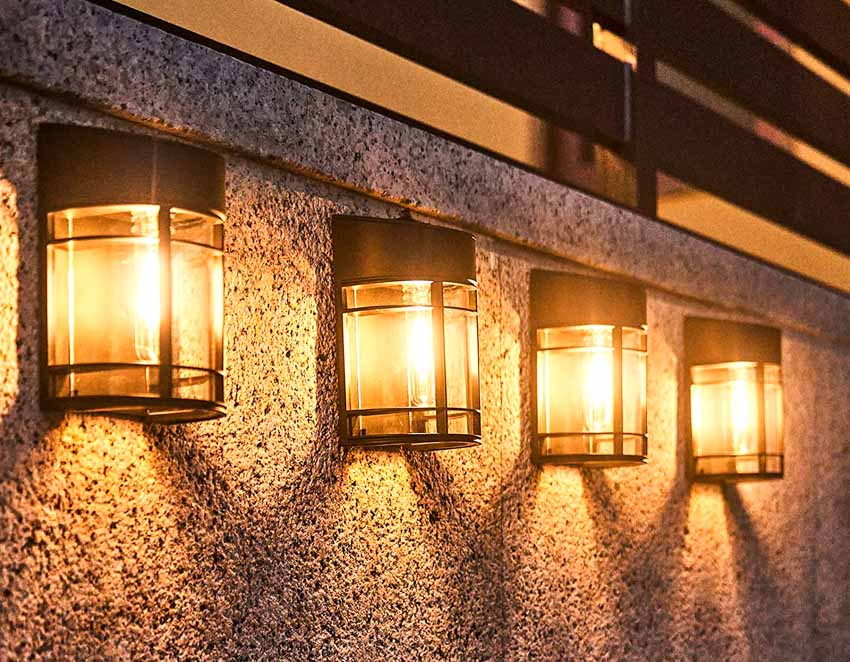
Similar to lanterns, sconce lights are elements of the past. The term “sconce” itself comes from the Old French and late Latin word that means lamp-holder. Sconces are usually depicted in movies and TV shows as lighting fixtures in old structures.
Some examples include castles and basements. Many of the sconces are paired with candlesticks and lanterns, but they will be different if you use them today.
Usually fixed to a wall, you can add these sconce lights to your fence. Most of the time, the focus is directed outwards and upwards, so make sure to consider that when deciding where to install them and how to position them for maximum function and use.
Installing them lower to the ground is better if you use them as some pathway light. Doing so would be better to be able to see where you’re going. Using one of the available landscape design software programs to help plan your layout may be a good idea.
Fence Light Features

Besides the different designs and styles you can choose for your fence lighting, you must also consider the different features.
Solar Power: Regarding power sources, solar power is present and the future. Electricity or battery powers many light fixtures, but if they are powered by the sun, you are doing something right.
If you use solar-powered fixtures, they would be significantly more expensive but will also be cost-effective in time. Think of this feature as an investment that you must put some cash on before enjoying its benefits.
If you choose solar-powered light fixtures, you will also use solar panels to generate electricity. The panels cost a lot, and without them, the fixtures won’t work in the first place.
When dealing with solar power, you must know that panels only convert about 10% of solar power to electricity and then keep the rest on reserve. An efficient solar panel can help recharge your battery faster.
The good thing about installing them on your fence is that they are exposed most of the time to the sun, which will help you gather enough solar power to turn your fixtures on and even have more for storage.
Post Cap: Another feature you must consider when lighting your fence is a post cap. This is more on the side rather than the lighting component. Post caps are the elements that secure the covering on the top of the fence post. They are frequently used for lighting for decks and fences.
They can come in various colors and materials, so you can always match them with your fence. This is why they are mostly seen as decorative elements of the fence. When it comes to materials, wood is a terrible choice for postcaps because they are prone to splitting, rotting, and pest infestation.
Vinyl fence post caps may be better, but they are not UV-resistant and become brittle after some time. And finally, you can consider plastic resin post caps, which are durable, UV-resistant, and even fade-resistant.
For the colors, black may be the most common postcap, and white is the least popular due to matching challenges. But there are also earthy colors to match the outdoors, including brown and green post caps.
Low Profile: Low-profile lighting fixtures are usually paired with lower ceilings but also for fencing that can produce ambient and decorative lighting styles. With this type, fixtures tend to have detailed and intricate patterns that can be stunning.
You can also use incandescent, fluorescent, and recessed lighting for low-profile fixtures. You can add this feature to your fencing to flush the fixtures for a more modern look.
Smart Lights: Another contemporary feature you can add to your fence is smart lighting, which is an advance fixture with software that’s connected to a smart home app and assistant.
Smart lights have intelligent features that may or may not include the following:
• Wireless remote-controlled lights
• Multiple brightness modes
• Sound-sensitive controls
• Automatic timers
• Wireless functionality
• Color-changing modes
• Motion sensor modes
Choosing smart lights for your fencing removes many hassles from using the fixture. While traditional bulbs are turned on and off using a physical dimmer switch, smart lights are coded with controls and commands that can be possible even when you’re not physically at home.
Many of these smart lights can be controlled wirelessly using your phone, tablet, or smart assistants like Alexa and Google Assistant.
This means that if you’re not at home and want to turn the fencing light on to add a layer of protection at home, it will be very convenient to have smart features at work.
If you are still looking into smart lights and exploring the options, here are the guaranteed benefits to look forward to:
• Energy-efficiency: Besides the bulbs lasting longer compared to traditional styles, smart lights use less heat and energy when in operation.
• Easily controlled: You can control the operation, from turning it on and dimming it to turning it on, without moving towards a switch.
• Automation: You can automate the turn-off of your smart lights after a few hours and automatically turn them off after the timer is set off.
• Connectivity: Smart lights are easily connected to devices, so more features can be accessed from this connectivity, from cameras to thermostats.
Long Battery Life: And finally, if you’re going to install fence lighting and have it powered either by a battery or solar power (through panels), going for an option with a long battery life will be very beneficial to you since you won’t have to replace them often.
Long battery life means a higher mAh rating, and when it comes to fence lighting, go for at least 400mAh or more to make the most out of this power source. If you want it to be much brighter, use at least 1200mAh capacity fixtures.
Your fence lighting must last long at night, which is important since it serves as added protection for your home at night. You can say that you have a good battery life if your fixtures can last for a continuous operation of at least 8 hours.
How To Choose Lights For Fences

Besides the incredible features to look for in your fence lighting, are there other factors you must consider when choosing?
If you want a bit of a guide in this choosing process, here are simple steps to follow:
Step 1 – Decide on the budget you are willing to spend: The budget for your lighting will be one of the most important factors to consider.
This choice can dictate if you can go with more expensive options filled with smart features or if you’ll be limited to cheaper fixtures for your fence with standard and common features.
Step 2 – Measure your fence and figure out how many light fixtures you need: Whether you have a fence made of posts or railings, measure the area you want to be covered with the fixtures. If you’re going for lanterns, sconces, and bulbs, you must count each fixture.
It will be much easier to use hanging and string lights since they have better coverage.
Step 3 – Take into account other important lighting factors when choosing the fixtures: More than just your budget, here are other important factors to consider before you even choose the outdoor fence lights to install at home.
• Brightness: Decide how bright you want your lighting to be. More fixtures will mean brighter and better coverage. And if you want to be more technical, more lumens will mean brighter illumination, so if you want a brighter perimeter, then settle for the fixtures with more lumens.
Every light fixture has around 10 to 100 lumens, and if you want a soft and ambient glow that fits well for dim and mood lighting, settle for fixtures with 10 lumens. However, if you want to have brighter illumination and focus more on security, get fixtures with at least 100 lumens.
• Light Temperature: Do you want an ethereal glow with a bit of warmth? If yes, incandescent bulbs would be great to consider. If you want your fence to be brightly lit so that you will be able to clearly see everyone and will feel safer and more secure at home.
When deciding on the light temperature, look at the number measured by Kelvin in K. For more yellowish and warmer lights, look for a lower K rating. Look for fixtures with a higher K rating for whiter and bluish illumination. Source: Westinghouse
• Design Style: Choosing the design all points towards the aesthetics and first impression you want your fence and, in general, your home to have. You can choose fixtures with intricate and detailed designs, like lanterns and sconces. Make sure whatever you choose is rated for outdoor use and is weatherproof.
The direction and orientation also play a part in your landscapes. A difficult corner may require a standalone lamp to get the lighting right. Are there trees, furniture, or other obstructions in the way that block lamp brightness and need to be relocated?
And you can also go for the option that offers better mood lighting, like fairy/string, hanging, and downlighting. Decide on the vibe you want to produce, and then match that vibe with the different options you can explore.
• Types Of Light Bulbs: Two of the most common bulbs used today are incandescent and LED bulbs, where the former is warmer and yellowish while the latter is more bluish-white.
LED is the way to go if you want a bulb that can last longer than other types of bulbs. LED bulbs can last up to 10 years so you won’t need to regularly change these bulbs, saving time, effort, and money in the process.
• Battery Life: When choosing lighting for your home that’s not powered by electricity, its battery life will play a vital role in your decision. Even if you choose solar-powered lights, they will still have batteries working for them, so it’s important to choose products with long battery life.
Choose lights with batteries that last at least 8 hours in continuous operation. For solar-powered light, 6 to 12 hours of battery life is the standard range.
• Solar Recharging Time: Choosing solar-powered lights is an excellent decision not just because of their low environmental impact but also because of the energy efficiency that translates to savings.
Compared to batteries that you would have to replace and recharge by plugging them in, solar-powered ones recharge through their exposure to direct sunlight.
Solar-powered lights for fencing are directly exposed to sunlight, which is better since they will be able to recharge faster. You must recharge the solar-powered lights for at least 8 hours to be fully charged and ready for operation at night.
• Installation: Installing your fence lighting depends on the type you use. For fixtures that need to be integrated into the fence, you will need more expertise or the help of a professional to install them properly.
You can style and do it yourself for hanging fairy lights and other fixtures that can easily be draped on the fence. This will help save you on costs rather than hire a contractor to do it for you.
How Do You Hang Lights On A Fence Without Nails?
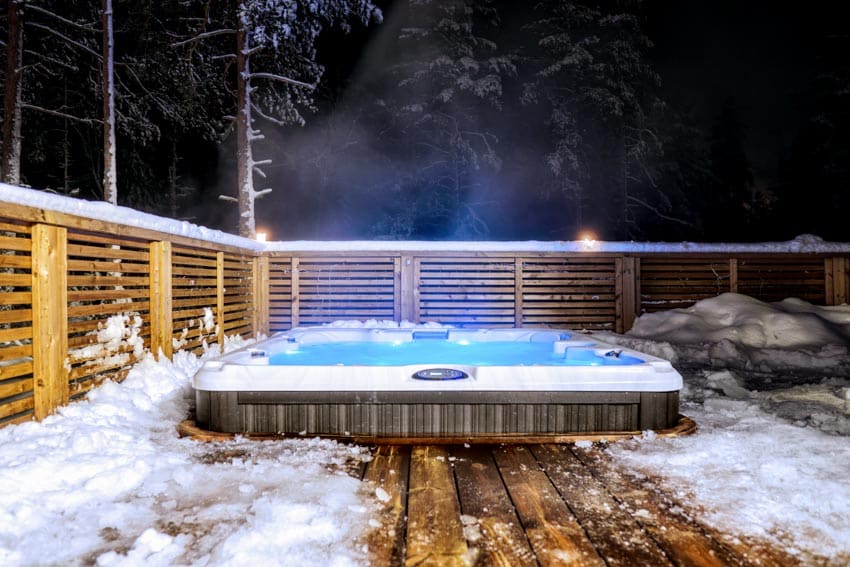
If you’re working on fairy and hanging lights but don’t want to work with nails, you can use some household tools and materials as alternatives. You only have to choose the ones that you feel comfortable working with. Some of these materials include the following:
• Hooks: There are two types of hooks you can consider as alternatives for nails, including gutter hooks and adhesive hooks. The former is an S-shaped hook that is considered a popular choice in the market. Conversely, the latter is a peel-and-stick hook that you can use on any flat surface.
• Staples: This nail alternative is a good material to use if you want a more stable installation on the fence, and you can easily remove them using pliers when needed. The downside, though is that you will create two small pinholes on the surface, and if you have a concrete or metal fence, this might not work well.
• Glue gun: Another nail alternative is a glue gun, which will help you avoid the need to drill holes in your fence and walls. While this option may work well, you won’t be able to avoid glue residue in the process.
• Tape: Tapes work well when it comes to sticking something to a surface, but you need to choose the right type of tape to use.
While duct tape is durable and sticks well to the surface, it will ruin the aesthetics. Clear tapes may be a better option since they will seem invisible.
• Zip ties: Ideal for hanging lights from one area to the next, zip ties are durable and sturdy to use. These materials are affordable and reusable, so you won’t have to buy them every now and then.
How Far Apart Should Fence Post Lights Be?
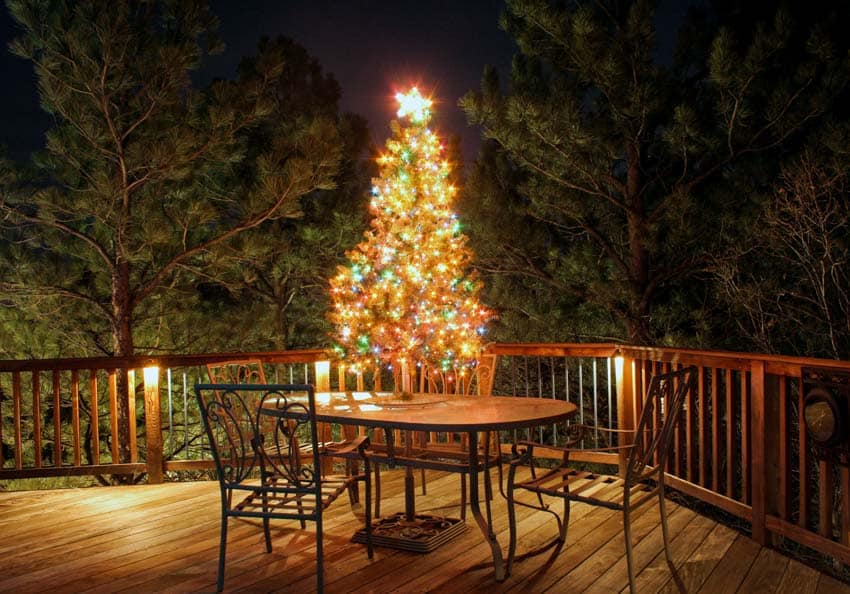
When installing fence lights, their placement is vital for proper coverage. You will need to consider the size and how bright you want the fence to be. Generally, you can install the light on each post to cover their area. But this won’t be an issue if you work on string and hanging lights.
The distance of the lights must also be considered if you are working on illuminating a pathway from your fence up to your home. In this case, the general rule is to ensure a light fixture every 5 to 8 feet apart.
Lessen the distance if you want a brighter pathway to walk on. You will also want to cover the entire pathway and have balanced lighting.
Are there any fence ideas we left out? Let us know in the comments your favorite fencing solutions or your experience implementing these solutions. See more related content in our article about the different types of garden fences on this page.

